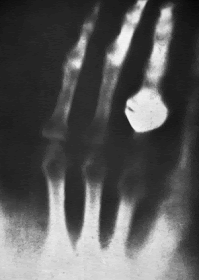 |
| Picture of Wilhelm Conrad Röentgen. |
X-Rays were first discovered in 1895 by German scientist,
Wilhelm Conrad Röentgen.
Roentgen won the first Nobel Prize in physics in 1901 for his discovery. While he was experimenting with electric currents passing through a tube, he realized that a nearby fluorescent screen began glowing as the current passed through.
When he switched the current off, the screen ceased to glow. Because the glowing could be attributed to unknown rays, he appropriately named them X-rays, which is the origin of the term we still use to this day.
One of the first x-rays taken was of his wife's hand, where he could see her hand and her wedding ring on the image.
 |
| The first human bones ever to be recorded with X-rays belonged to Bertha, Wilhelm Röntgen’s wife. |
The implications of the technology were huge and the medical community recognized its worth in diagnosis of various broken bones, fractures, and ailments. Within a few months of the discovery, machines were produced to be used in the medical community and it wasn't long before they were a widespread, commonly used technology.
